There have now been four versions of A Star is Born, but none have captured the power of such an immense talent like the 1954 film, starring one Miss Judy Garland. Tragedy is a running theme throughout all versions of the film—but Judy’s version was tragic in more ways than one. And only when the film was revived, three decades later, did it finally begin to be recognized as the heroic and risky endeavor it was.
Before Streisand and Gaga, A Star is Born was supposed to be Judy Garland’s monumental film comeback. Released from her contract with MGM after fifteen years just a few years prior, toppled with a series of notorious personal struggles and erratic behavior that her industry created and didn’t know how to treat, Garland needed a vehicle to drive her back to the top more than anyone. Judy and her new husband, Sid Luft, formed their own production company, Transcona Enterprises, and partnered with Warner Bros. to remake the 1937 film, originally starring Janet Gaynor and Frederic March. But rather than showcase her talent and profound vocal range, the 1954 version would be better remembered for its troubling release—and the beginning of the end for Judy.
Judy Garland—born Frances Ethel Gumm in Grand Rapids, Minnesota in 1922—was practically a star from the moment she was born. Her parents owned a vaudeville movie theatre, where she made her stage debut with her older sisters at the age of two and a half. She grew up performing in an act with her family, known as the Gumm Sisters where she held the nickname Baby, accompanied by her mother on piano. By 1935, the family group had withered and Baby—now renamed Judy Garland—was signed to a film contract with Metro-Goldwyn-Mayer (MGM). The studio famously signed her without a screen test (which was practically unheard of at the time) but would then struggle to find the right place for her for years to follow. At thirteen, she was too old to be considered a child star, but too young for adult roles. While she was paired with Mickey Rooney in a series of successful “backyard musicals” in the late 1930s, Judy’s charm failed to shine through when she compared to fellow MGM star Deanna Durbin, with whom she would star in the 1936 musical short Every Sunday. As a result, Garland came to be known as the ugly duckling on the MGM lot (studio boss Louis B. Mayer even used to refer to her as his “little hunchback”), causing her physical appearance to constantly be manipulated by film executives. To make matters worse, even though Judy was always of a healthy weight, the studio was convinced she was too fat to be a star and not only was she put on diet pills, but her food intake was consistently monitored—at one point she was only ever served soup and a plate of lettuce, and her food was often confiscated if she tried to eat more. Diet pills, combined with amphetamines that the studio forced many of their young actors to take to fulfill nearly impossible work demands, is believed to have severely contributed to Garland’s lifelong struggle with drug addiction. In addition to being completely reliant on prescription medication, Garland was plagued by self-doubt into her adulthood, and despite groundbreaking professional success, she needed constant reassurance that she was talented and attractive—all of which is generally thought to have been caused by her early days at MGM.
- Garland as Esther Smith in Meet Me in St. Louis, 1944 (Source: TCM)
Despite issues behind the scenes, Judy would enjoy great success in numerous MGM films, appearing in over two dozen films for the studio in fifteen years. She is perhaps best remembered in our contemporary conscious as the girl who wanted to fly over the rainbow; a young Dorothy Gale in The Wizard of Oz (1939). Other notable films for MGM include Meet Me in St. Louis (1944), The Harvey Girls (1946), Easter Parade (1948), and Summer Stock (1950). During this time, she met and married director Vincente Minnelli and had her first daughter, Liza, in 1946. Things quickly started to go downhill thereafter—she suffered a nervous breakdown and made her first suicide attempt during production of The Pirate in 1947 and spent time in a private sanitarium. While she had recovered enough to perform well in Easter Parade with Fred Astaire and In the Good Old Summertime with Van Johnson, she was fired from another production and conducted a stint in a hospital in Boston, where she was weaned off the medication she heavily relied on. She returned to Hollywood heavier and healthier in 1949, where she was cast opposite Gene Kelly in Summer Stock—but the studio demanded she lose weight again, causing her familiar pattern with diet pills and amphetamines to resurface. Summer Stock, which would prove to be her final film with MGM, took six months to complete: Garland would often show up late or not at all, worsening tension with MGM executives. The film proved to be largely successful, but the studio lost $80,000 due to production delays caused by Judy. Although she was cast in the film Royal Wedding with Fred Astaire in 1950, her now notorious unreliability caused her to be fired early in the production. After this latest dismissal, Garland was said to have slightly grazed her neck with a piece of broken glass, but the media reported that a despondent Judy had slashed her throat. In September 1950, after fifteen years, MGM and Judy Garland parted ways.
Garland’s second daughter, Lorna Luft, writes in the new book A Star is Born: Judy Garland the Film That Got Away that her mother never really wanted to die when she attempted suicide—they were merely pleas for attention and literal cries for help. “Mama’s suicide attempts were last resort methods to gain attention and release anxiety,” Luft says. “I believe she felt trapped, misunderstood, and was making a desperate plea for understanding.” But just as inexplicably as her childhood stardom began, Hollywood’s perception of Judy Garland was quickly changing. “Without MGM resources to shield her … she was now a deeply troubled celebrity,” writes Luft. “She had endured electroshock therapy and various hospitalizations. After fifteen years and twenty-nine movies, Mama was suddenly unemployable in the movie business at age twenty-eight, running low on funds, and running on old friends to see her through. Emotionally, physically, and financially, my mother was spent.” Following a series of nervous guest appearances on Bing Crosby’s radio show just a few months later, Garland quickly saw renewed success on the stage, beginning a concert tour throughout Europe and North America with an appearance at the Palace Theatre in New York City in October 1951 breaking records for the venue. After divorcing Vincente Minnelli and quickly remarrying to Sid Luft, a film industry figure, in 1952, Judy needed a real comeback—one that would prove that she had the talent and strength to lift herself back up to the top after falling down so low. Together, Luft and Garland formed Transcona Enterprises, their own production company, and partnered with Warner Bros. to produce a musical remake of A Star is Born. Studio head Jack Warner was willing to take a gamble on Judy, giving her more creative control than she had ever had on a film, and Sid Luft promised to make her feel safe during production. And as Lorna points out, her father was a natural gambler, and in his eyes, “Mama’s motion picture comeback was a long shot horse than just might finish in the money.”
- Garland and James Mason as Vicki Lester and Norman Maine during production of A Star is Born (Source: Warner Bros.)
Directed by George Cukor, whom Garland had worked with during her early days at MGM, A Star is Born was more than just Judy’s motion picture comeback—the plot, music, and dialogue hit remarkably close to home, which made the film enormously personal for her. Out of its many musical numbers, among those best remembered are “The Man That Got Away,” which became one of Judy’s signature adult songs, and the iconic “Born in a Trunk” medley, which runs for over fourteen minutes and is even included in its entirety on the soundtrack—but was criticized by studio executives for running too long and was labelled a distraction that was out of key with the rest of the film. Regardless, A Star is Born quickly became more than just a musical film starring Judy Garland—it was very much a showcase for Judy’s indescribable talent first, and a musical film second. “Hers is the only solo voice heard in the picture,” Lorna Luft writes, “making it a virtual one-woman concert held together by a dramatic narrative.” It should then come as no surprise that Time magazine famously referred to Garland’s A Star is Born as “just about the greatest one-woman show in modern movie history.” Judy stars as Esther Blodgett, a chorus girl and aspiring singer with a band. Garland and Sid Luft had wanted Cary Grant to play the male lead and Warner Bros. had offered it to Marlon Brando, but it ultimately went to British actor James Mason, who co-starred as Norman Maine, a former matinee idol whose career is quickly on the decline. Seeing a star quality in Esther, he offers to help make her just that—a star—believing she possesses “that little something extra.” Later renamed Vicki Lester by a Hollywood film studio, Esther’s relationship with Norman grows, as does her career—and as does his dependence on alcohol. As much as displaying her transcendent vocal ability, A Star is Born also displays Garland’s profound ability as a dramatic actress, during which it becomes clear that the plot of the film hit very much close to home for Judy. Referring to one standout scene where Esther expresses her fears towards Norman’s addictions, Luft writes that the screenwriters knew these kinds of dialogue would speak to Garland on several different emotional levels, especially regarding her own failures and drug dependency. “Cukor allowed Judy Garland the performer to be fully herself, thus creating such a moment of intensity and raw emotion that is heartbreaking to watch,” she says. “This release of unfiltered pain, probably more than any other scene in the film, confirmed Mama’s gifts as not only a singer and dancer, but as one of the great dramatic talents of her time as well.” Cukor also recalled asking Judy to dig into her own personal experiences that closely aligned with the film’s story, saying she would never realize what an effect her talent and abilities had, and would then break the serious moment with a joke in her signature sense of humor.
“The picture had to be the greatest... it could be merely very good. I had too much at stake... I had to prove things.” —Judy Garland
- Garland as Vicki Lester accepting her Academy Award in A Star is Born (Source: Warner Bros.)
Judy retained many of her unreliable work habits that had plagued her on the MGM lot but always managed to show up and get the day’s work done as best she could, as she really believed in the star vehicle that was A Star is Born. James Mason recalled working with Garland in his autobiography and defended her infamous unreliability, writing, “Judy was not always reliable, in fact there were some days when she would not really be fighting fit until after the lunch break … If the film went over budget only a very small fraction of the overage was due to Judy’s erratic time table … Judy was by no means a temperamental star. ‘Temperamental star’ is usually a euphemism for selfish and bad tempered, and a temperamental star of this sort can be a real time-waster. I have worked with some. And they are more rampant now than they used to be. But this was not Judy.” Although Warner work logs indicate that Garland often left the set early or didn’t show up at all, Luft writes that when she was on her game, she was a prepared professional. “She was also lightning fast—one rehearsal and she was ready to roll,” she says. “One reading of a page and her lines were committed to memory. Her photographic memory was extraordinary.” Initially budgeted at $3 million, the final cost for A Star is Born ended up twice that figure, making the film the most expensive ever shot in Hollywood at that time—and for which Warner Bros. largely blamed Judy for delaying production with her eccentricities. A Star is Born, running 181 minutes, had its world premiere in Hollywood on September 29, 1954, where it was an undisputed mass success. The initial reviews were ecstatic. Time wrote, “An expert vaudeville performance was to be expected from Judy; to find her a dramatic actress, as well, is the real surprise,” and said the film was a “stunning comeback.” In a more mixed review, the Los Angeles Times described Garland’s performance as “overstressed,” and “potentially a target for strong critical resistance,” presumably because the film was considered too long and “overburdened” with trying to prove itself, and they felt its emotional scenes were forced. But still, they admitted that the musical “put a brilliantly shining crown upon the dark-tressed head of Judy Garland … Here was her super-picture.” Critics could not deny the film’s grandeur. Luft writes that her mother was thrilled by the overwhelmingly positive reception. “Because her reputation had been somewhat tarnished by her later years at MGM, she was particularly gratified that her peers, the critics, and the industry as a whole now embraced her and A Star is Born. She had cut her losses, started fresh at a new studio (with a new husband-producer in her corner), and had succeeded on a grand scale … It must have been one of the most rewarding periods in Mama’s career.” But the recurring complaint was the film’s length—181 minutes of Judy Garland’s talent proved to be too much for some, and as early as a month after the film’s premiere, theatre owners were complaining that they could only screen the film a limited amount of times a day due to its length. “They had wanted a box-office-friendly blockbuster that they could unreel four times a day,” writes Luft. “Jack Warner heard the grumblings, but was not inclined to axe thirty minutes out of a picture in which he was personally invested, a film of which he was truly proud. But at the Warner offices in New York City … the word was ‘cut!’” Thus, A Star is Born was infamously gutted down to 154 minutes—cutting out several crucial scenes—and the trimmed film was sent back to Warner Bros., where they were said to have been destroyed, and the 181-minute original version that opened to immense acclaim was never seen in its entirety again. “It’s insanity thinking about it now,” says Luft. “No projectionist would take a pair of scissors to a Spielberg movie. The entire job was botched. They did surgery on a healthy patient without anesthesia, removing major organs and expecting the patient to survive.”
“It's insanity thinking about it now. No projectionist would take a pair of scissors to a Spielberg movie. The entire job was botched. They did surgery on a healthy patient without anesthesia, removing major organs and expecting the patient to survive.” —Lorna Luft
Garland was absolutely devastated by what had been done to A Star is Born—Liza Minnelli, then eight years old, recalls the night that her mother found out about the cuts and came up to her room where she said in uncontrollable in tears, “They just don’t care.” Luft says it only got worse from there. “Suddenly, lawsuits were threatened and pursued against my father, in separate actions by Harry and Jack Warner, each claiming my father had wrangled loans from them in the course of making the picture,” she writes. “The dollar amounts were negligible to the mogul brothers, but the point seemed to be the shaming of Sid Luft, whom they had both come to personally loathe … Dad had gambled once too often with the big guys, and lost again.” Despite the critical praise of the initial version as well as a multitude of Judy’s celebrity friends spreading word of mouth, the butchered version of A Star is Born was a financial failure. “The fallout was more than just a disappointment or an economical loss,” Luft says. “It was personal failure for Judy Garland—one from which her film stardom would never fully recover.”
- In hair and makeup during production, 1953 (Source: TCM)
Despite Warner Bros. not mounting much of an Oscar campaign for Garland or A Star is Born, the film managed to receive six Academy Award nominations in 1955. Judy had brought home a Juvenile Oscar for her work in The Wizard of Oz years prior, but she craved a real Oscar win—one that would confirm to the film industry that she was the star everyone knew her to be, but also to herself. On the evening of March 28, 1955, the night of the 28th Academy Awards, Garland went into premature labor with her third child, Joseph Luft. NBC sent a film crew to her hospital room to televise Judy’s acceptance speech, as during the leadup to the Oscars that year, she had generally been expected to win for Best Actress. That was tragically not the case, as the award went to Grace Kelly for The Country Girl. In a 1957 article published in McCall’s, Garland recounted that Oscar night experience, saying the technicians attached wires under her bedsheets and caused a panic among the nurses. When she didn’t win, she stated she didn’t even have time to be disappointed. “I was fascinated by the reactions of the men,” she said. “They got mad at me for losing and started lugging all their stuff out of the room. They didn’t even say goodnight.” Grace Kelly had only been working in Hollywood for four years at that point, as opposed to Garland’s two decades. Groucho Marx famously referred to her loss as “the biggest robbery since Brinks.” Judy’s close friend Lauren Bacall was with her in the hospital that Monday night, and wrote later that she was gracious in defeat, saying her baby boy was much more important. Bacall recalled, “The big night came and we were all gathered around our sets praying—and Judy lost. She carried it off beautifully, saying her son, Joey, was more important than any Oscar could be, but she was deeply disappointed—and hurt. It confirmed her belief that the industry was against her. She knew it was then or never. Instinctively, all her friends knew the same. Judy wasn’t like any other performer. There was so much emotion involved in her career—in her life—it was always all or nothing. And though she put on a hell of a front, this was one more slap in the face. She was bitter about it, and, for that matter, all closest to her were.”
- Garland in a production still from A Star is Born that would later be used as the cover for her 1956 studio album Judy with Capitol Records (Source: TCM)
A Star is Born may have marked the beginning of the end of Judy’s film career, but every cloud has its silver lining—the success of the soundtrack led to Garland signing a recording contract with Capitol Records, with whom she would release eight studio albums in the years following. Her dependency on prescription medication grew stronger, and her marriage to Sid Luft quickly grew weaker. She aimed her focus on her recording career and concert appearances thereafter, with two performances at Carnegie Hall in April 1961 hailed by Variety as “the greatest night in show business history.” The live album Judy at Carnegie Hall saw large success and made Garland the first woman in history to win the Grammy Award for Album of the Year. Around that time, new management promised to revive her acting career: she played a victim of Nazi persecution in Judgment at Nuremberg (1961), for which she was nominated for the Academy Award for Best Supporting Actress. Known for being unable to sufficiently manage her own finances and on the verge of bankruptcy, Garland hosted her own variety series on CBS, The Judy Garland Show (1963–1964), which served as a new showcase for Judy’s talent but was plagued by production and format issues from the beginning and was cancelled after one season. Despite prominent offers in the years after, Judy’s final film was I Could Go on Singing in 1963. Due to her unstable financial situation, Garland maintained a gruelling concert schedule and never stopped performing for the remainder of her life and career—she died of a barbiturate overdose in June 1969, at the age of 47.
By the 1970s, Luft recalls that Judy’s version of A Star is Born had become a cult classic rather than the monumental film event it was intended to be. “[It] was kept alive in a butchered form as late-night television programming and remembered fondly by those lucky few who had seen and remembered the film in its original full-length version,” she says. But the late 1970s and early 1980s also marked an evolving concern for the state of Hollywood classics—cable television and the advent of home video began generating a greater interest in older films. Ronald Haver, at the time head of the Film Department at the Los Angeles County Museum of Art (LACMA), thought he might have a chance to rescue one of his favorite films, A Star is Born starring Judy Garland, believing that the original 181-minute version of the film might still be out there somewhere. Another catalyst for reviving Judy’s A Star is Born was the success of the second remake with Barbra Streisand and Kris Kristofferson. Haver, along with representatives from the Academy of Motion Picture Art and Science, acquired the approval of George Cukor to attempt to reconstruct the 1954 version of the film that had been so carelessly destroyed. An apprentice editor at Warner Bros. discovered and located the complete 181-minute monaural soundtrack in the studio sound library but unfortunately, not all of the camera footage to accompany it. They were, however, able to recover and reconstruct one entire scene with both sound and picture—the proposal with Vicki Lester singing “Here’s What I’m Here For” and the microphone pickup of Norman and Vicki’s intimate conversation. Over twenty minutes of camera footage otherwise remained missing. Still dedicated to reconstructing the film, Haver ultimately used the complete 181-minute soundtrack that had survived supplemented by still photographs from the film to recreate what had been lost. The reconstructed version of A Star is Born premiered in 1983, running 176 minutes, and was reborn not only to new audiences but to a new generation who could now experience Judy Garland’s finest work in the closest form possible to the original. Sadly, director George Cukor died of heart failure two days before the first screening. The reconstructed version was then seen as a tribute to him and as a case study in the importance of preservation. Haver chronicled his journey rebuilding the film in the book A Star is Born: The Making of the 1954 Movie and Its 1983 Restoration, published in 1988.
It can only be described as a tragedy that Judy Garland did not get to
experience the same amount of widespread, commercial praise and acceptance that
both Barbra Streisand and now Lady Gaga have experienced with their own
versions of A Star is Born. Contemporary
tributes to Judy still remain prevalent, and one can only hope that her talent
and true star quality will never be forgotten. Gaga is also no stranger to Judy’s
power. “Judy Garland is by far my favorite actress of all time,” she told Vogue this month. “I used to watch her
in A Star is Born, and it’s
devastating. She’s so real, so right there. Her eyes would get glassy, and you
could just see the passion and the emotion and hear the grit in her voice.”
Lorna Luft is happy about where her mother’s version of A Star is Born remains now. “Today, my mother’s film is readily
available for anyone who wishes to see it in a version as close to the original
version as possible,” she says. “Like Dorothy in The Wizard of Oz, Esther Blodgett/Vicki Lester in A Star is Born is earnest, innocent, and
appealing, yet displays a strong inner quality that allows her to persevere.”


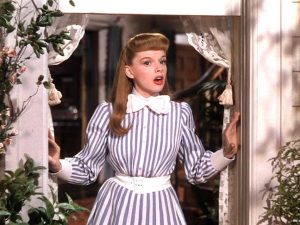
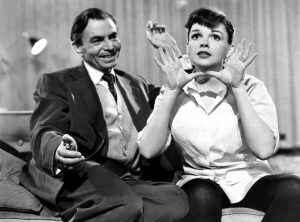
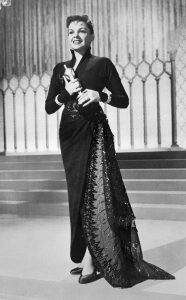
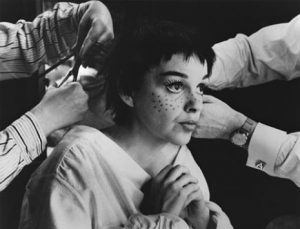
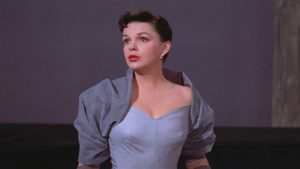
Being that Sid Luft was one of the producers of Garlands A Star is Born...it just boggles my mind that a complete uncut film does not exist.
ReplyDelete